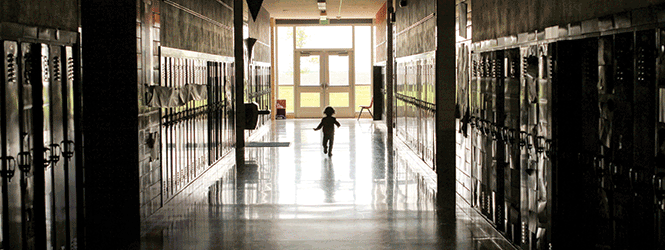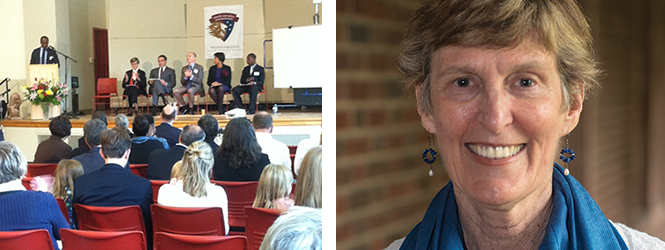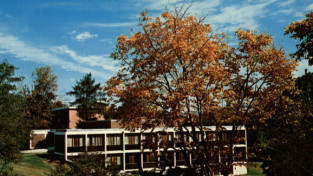Access to Education
Expanding opportunities for low-income students in America
 During a bitterly contested election, a senator gives a closely watched speech on education. “We are not attracting bright young men and women into teaching because the salaries which we pay our teachers are shamefully low,” the senator says. Some school districts are in debt, and students far overflow available classrooms; the candidate tells of one low-income community forced to hold classes in a converted dog kennel.
During a bitterly contested election, a senator gives a closely watched speech on education. “We are not attracting bright young men and women into teaching because the salaries which we pay our teachers are shamefully low,” the senator says. Some school districts are in debt, and students far overflow available classrooms; the candidate tells of one low-income community forced to hold classes in a converted dog kennel.
It’s easy to assume that this speech was given during one of the more recent presidential elections or even in the run-up to this year’s midterms. But calling for educational opportunities for low-income children was a hallmark of Massachusetts senator John F. Kennedy’s 1960 campaign and presidency. In a 1963 speech Kennedy stated that when compared to “a white baby born in the same place on the same day,” an African American child had “about one-half as much chance of completing high school,” “twice as much chance of becoming unemployed,” and “a life expectancy seven years shorter.”
“Those stats have not really moved,” says Aimée Eubanks Davis ’95, Teach for America’s executive vice president for people, community, and diversity. “That is just troubling.”
In January, the issue of access to high-quality education brought Mount Holyoke president Lynn Pasquerella ’80 to the White House, where eighty-five college leaders pledged to increase opportunities for low-income students. It’s an issue that has also drawn alumnae from diverse backgrounds and philosophical beliefs into the field of education, and each of them approaches the problem in her own way.

Left: Dedication ceremony for Washington
Latin Public Charter School in 2013. Right: Martha Cowen Cutts ’68
Martha Cowen Cutts ’68, a 2013 winner of the Alumnae Association’s Elizabeth Topham Kennan ’60 Award for her outstanding contributions to education, had spent thirty-seven years in elite independent schools when she got a call about an interim position at a charter school in Washington, DC. At the time that she took over, the school was only in its second year and classes were being held in a church. “My previous school was founded in 1869 and this one in 2006,” she says.
The position was supposed to be for six months; Cutts is in her seventh year as head of school. She rapidly raised money for a new facility, hired new teachers, and kept class sizes small. Under her tenure, Washington Latin Public Charter School earned the highest graduation rate of any non-selective school in DC. “We have the right faculty, the right hires, and we created a culture,” Cutts says.
Echoing decades of research linking diversity to high school performance, Cutts says that balance in the student body’s socioeconomic and racial makeup is key to Washington Latin’s success. “Unlike most public schools in the city, this is a mix, and the mix is important,” she says.
A 2010 study by UCLA’s Civil Rights Project found that, despite their original mandate, charter schools were more segregated than other public schools. According to the study, 70 percent of black charter students attend schools in which ninety to 100 percent of students come from underrepresented minority backgrounds. To some degree, Washington Latin bucks the trend; 52 percent of students there are African American, 33 percent are white.
In Washington, more than 44 percent of public school students attend charter schools through a common lottery system. Washington Latin had more than 800 children on the wait list last year and a 51 percent increase in applications this year, says Cutts, who worries that the school’s growing reputation could eventually cut into opportunities for low-income and minority students.
“If we have fifty spots infifth grade, but you have three times as many middle- and high-income students applying, the chance that those applicants will get in will be greater,” Cutts explains.
That could threaten the balance at Washington Latin, where, Cutts says, “the socioeconomic racial diversity is the exemplar for what public schools should be.”

Left: Crys Latham ’00 is optimistic about the DC Promise Establishment Act, which would provide additional aid for District students.
Right: Pre-schoolers take part in the DC Promise Neighborhood Initiative, a US Department of Education program aimed at increasing access to quality education.
Having seen firsthand the effects of the recession on families at Washington Latin and elsewhere, the school’s college counselor, Crys Latham ’00, is optimistic about programs like the DC Promise Establishment Act, which would provide additional aid for District students.
During the 2008 recession and its aftermath, Latham watched students have their academic careers disrupted by financial instability. “I had a student in the class of 2012 who went to an out-of-state public university and then had to come back after their first year and go to a community college,” due to economic hardship. “Once a student leaves a school, that can greatly affect their ability and motivation to complete their degree, because now there are obstacles they hadn’t anticipated.”
Having been an admission officer at three Ohio universities, Latham also had a unique understanding of the skills students were lacking when they got to college. “I was surprised; even kids coming from privileged backgrounds didn’t understand money,” she says. When she arrived at Washington Latin, she created a financial literacy program—now a graduation requirement. She works with students to chart their academic paths, including financial components, beginning in ninth grade. “A lot of what we do here is not just college admissions. I try to incorporate life skills,” she says. “It’s not just test scores. It’s how to function away from home; how do you balance your checkbook; what does it mean to have a credit card.”
A first-generation college student who grew up homeless at times, Latham says her perspective helps inspire students whether they are from privileged or low-income families. “I used to be very embarrassed about sharing my background,” she says. “But it’s an opportunity for me to talk to them about [the importance of] staying motivated and using the resources they have and being resilient.”
“Motivation, tenacity, grit, whatever buzzword you want to choose, isn’t necessarily something you can teach,” she says. “But I try to help the kids to understand that those traits can benefit them in the future.”
Marylee Guida Moulton ’85 was working in marketing for a financial services company when her husband was transferred to Mississippi and then Arizona with the Air Force. During the transitions, she decided to stay home with their three children—her eldest is now a Mount Holyoke College senior, Erica Moulton ’14. “I became really involved in their education,” she says. “I served in every volunteer position I could.”
Arizona was already among the lowest-ranked states in the country in terms of spending per pupil. But from 2008 to 2013, spending per student dropped by more than 20 percent, the worst in the country, according to the Center on Budget and Policy Priorities. Moulton and other parents began organizing across the southern part of the state. “We went from being an ad hoc organization to actually founding a nonprofit,” says Moulton.
That organization, the Arizona Education Network, is a non-partisan information network that campaigns for greater public-school funding. It was part of a coalition that brought forward Proposition 100, an emergency 1 percent increase in sales tax, two-thirds of which was designated for primary and secondary education. The bill was backed by Governor Jan Brewer and passed in 2010.
But the bill was due to expire three years later, so the education network worked to sponsor an extension, Proposition 204. “We got it on the ballot, and our original polling was very good, close to 70 percent,” Moulton says.
Then Americans for Responsible Leadership, a political nonprofit recently sanctioned for spending $11 million of “campaign money laundering” in California, spent nearly a million dollars on a campaign to defeat Proposition 204 in Arizona. The so-called “dark money” group was involved in another campaign finance violation in California with the Center to Protect Patient Rights, an organization connected to the billionaire Koch brothers, known for their support of conservative policies. “When I’m faced with someone who can give a million dollars in a campaign, how do you fight that?” Moulton asks.
Moulton and her family now live in Nebraska. She is pursuing a master’s degree in communications, which she hopes will help her defeat corporate lobbying on issues like education. In Omaha, her youngest daughter is in public school. “In Nebraska, if [the district] decides that something is worth doing, then all schools should be able to do it, and the school district should pay for it,” she says. “It’s a night-and-day difference.”
Aimée Eubanks Davis ’95 was “dodging law school” and considering a career in the Peace Corps before choosing to pursue a job with Teach For America. She decided she wanted to stay domestic. “I was placed in New Orleans and fell in love with the students and the community there,” she says.
After two years with Teach For America and a couple more managing programs with Breakthrough Collaborative, an organization that provides preparatory summer programs for middle school students, Eubanks Davis moved back to Chicago, where she crossed paths with Wendy Kopp, the founder of Teach For America. “We started talking about why I had never joined the staff of Teach For America,” she recalls. Kopp eventually offered her a job as vice president of new site development, working closely with her to oversee the organization’s growth. Eubanks Davis says she recognized the offer as “an opportunity to work alongside one of the most revolutionary people working in educational nonprofits.”
Working with Kopp, Eubanks Davis helped expand Teach For America into South Dakota, Las Vegas Valley, Charlotte, Miami, and Philadelphia, and doubled the size of the corps in New York. “That happened faster than expected,” she says. While Eubanks Davis was considering business school, Kopp convinced her to take a role in regional operations and, later, to become special vice president for human assets, where she witnessed the largest period of growth in Teach For America’s history, from a few thousand corps members to 10,000 nationwide.
As she has moved from teaching to climbing the ladder of the business side of education, Eubanks Davis has also begun to take a big-picture look at learning opportunities. “Traditional education is no longer the leveler it used to be,” she says. “It’s about kids having high-quality experiences and opportunities that expand their learning.”
“Higher income families in the last forty years are spending triple the amount on expanded learning and enrichment activities for their children,” she says. “Lower income families are spending about the same amount they spent forty years ago.”
Teach For America surveyed second-generation corps members, one-time students who went on to work for the organization, asking which experiences had given them leadership skills and which enrichment opportunities were missing. They conducted a similar study of business analysts at a respected consulting firm, most of whom came from middle- or upper-class backgrounds. Among the analysts, says Eubanks Davis, “almost all of them [identified] middle school as a time when they started to develop leadership skills, and many of them talked about learning about themselves as leaders at overnight summer camps.” Having grown up in low-income communities in Chicago, Eubanks Davis was flummoxed. “I was not a kid who went to overnight summer camp,” she says. “I was like, what is this?”
The study prompted Eubanks Davis to take a second look at the needs of public-school students and to consider the importance of foundational skills as well as a good education. “Sometimes I fear we haven’t taken a twenty-year lens in really setting up people to have the suite of opportunities that go hand in hand with the academics.”
Educational attainment and employment numbers over the last forty years indicate that attaining the American dream, especially if you are born poor, is harder than ever before. “It’s been one of the toughest nuts the country has yet to crack,” Eubanks Davis says. “How do you ensure that all kids, especially those in low-income communities and underrepresented backgrounds, can truly get a high-quality education, which often leads to having better life opportunities?”
When asked what she thinks does work, Eubanks Davis pauses, and then echoes a statement made by many alumnae in education. “You know what doesn’t work?” she says. “What doesn’t work is when anyone says that their way is the only way, that they have the silver bullet.”
—By Jill Dunham ’97
Jillian Dunham ’97 is the founding editor of The Curie Review, a publisher of women’s archives and narratives.
Know an alumna educator?
Know an alumnae educator who should be recognized for her outstanding achievement in the field of education? Nominate her for an Elizabeth Topham Kennan Award.
This article appeared in the spring 2014 issue of the Alumnae Quarterly.
April 17, 2014










Leave a Reply